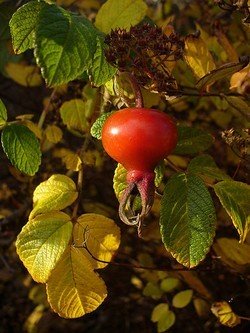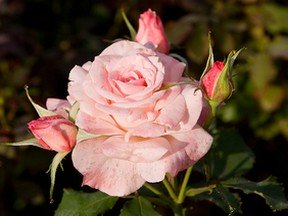Growing Roses - Your
Foolproof Guide to Rose Care and How to Grow Roses
Many people feel that there is a mystery to this well loved plant, and that they are difficult to grow. It is just the opposite! They aren't! But you do need to make sure that the roses that you choose to grow are the right type for your needs, get a lot of water, and the climate is not too hot and humid.
Growing Roses and Rose
Care
If you want to grow roses in mixed shrubbery borders, then the single and informal types should be chosen. The best of all these is Rosa rugosa.
 Growing roses like the Rosa rugosa not only
gives you
attractive
flowers through the greater
part of the season, but it also has very interesting foliage and a
striking habit.
Growing roses like the Rosa rugosa not only
gives you
attractive
flowers through the greater
part of the season, but it also has very interesting foliage and a
striking habit. Even without the flowers, it has an attractive mass of foliage. The foliage is not attacked by insects or fungi, but remains green and glossy throughout the year.
The fruit, or rose hips are also very large and showy, and persist on bushes well through the winter.
Some of the wild roses are also excellent for mixing into foliage masses, but, as a rule, their foliage characteristics are rather weak, and they
are liable to be attacked by thrips.
Growing Roses - Different Classes and Types
Outdoor roses may be divided into two groups so far as their blooming habit is involved:
(1) The continuous or intermittent bloomers, such as the hybrid perpetuals (blooming chiefly in June), bourbons, tea, rugosa, the teas and hybrid teas being the most continuous in bloom;
(2) and those that bloom once only in summer, as Austrian, Ayrshire, sweet briers, prairie, Cherokee, Banksian, Provence, most moss roses, damask, multi flora, polyantha, and memorial (Wichuraiana). "Perpetual" or recurrent-blooming races have been developed in the Ayrshire, moss, polyantha, and others.
Preparing the Soil for Your Roses
 Growing
roses cannot take place in any type of soil in order to get the best
results.
Growing
roses cannot take place in any type of soil in order to get the best
results.The best soil for roses is a deep and rich clay loam, although any ordinary soil will do, provided it is well manured. And a clay soil is good too, as long as it is well drained and allows excess water to move away from the root zone.
Cow manure is strong and lasting, and has no heating effect. It will cause no damage, even if not rotted. Horse manure, however, should be well rotted before mixing it with the soil.
The manure may be mixed in the soil at the rate of one part to four. You cannot add too much compost and manure to soil where you are growing the hybrid tea roses. You should also add a good handful or two of blood and bone to your compost manure mix. Spent mushroom compost is also good if added to the soil.
If you have very sandy soils then you will need to improve the soil by adding a lot of compost and manure and other organic matter to enrich the soil.
If you have soil that is naturally acid then add lime at the same time as you are adding compost and manure to your rose holes. Use about 2/3 cup per square meter on sandy soils and double this quantity on heavy soils.
When preparing the rose holes they should be dug deep and then filled with the compost and cow manure at least 4-6 weeks before planting.
By the time you come to planting your roses out the soil should be in a good crumbly condition. To get it to this stage you need to dig the soil over again about 2 weeks before planting to break up any clods and to mix in the organic matter as it continues to break down.
Planting your Roses
In rose planting, care must be taken to avoid exposing the roots to the drying of sun and air. If dormant field-grown rose plants have been purchased, all broken and bruised roots will need to be cut off smoothly and squarely.The tops also will need cutting back. The cut should always be made just above a bud, preferably on the outer side of the cane.
Strong-growing roses may be cut back one-fourth or one-half, according as they have good or bad roots.
Weaker-growing kinds, as most of the ever-blooming roses, should be cut back most severely. In both cases it is well to remove the weak growth first. Plants set out from pots will usually not need cutting back.
Where to Plant Roses
When growing roses, while roses grow well in a sunny position, a dry atmosphere and hot summers are sometimes trying on the flowers, as are severe wintry winds on the plants. While, therefore, it is never advisable to plant roses near large trees, or where they will be overshadowed by buildings or surrounding shrubbery, some shade during the heat of the day will be a benefit.
If you live in the tropics give your roses 6 hours of sunshine a day, and allow for some shade. This will also prevent your blooms from fading.
The best position for planting roses is on an eastern or northern slope, and where fences or other objects will break the force of strong winds, in those area where such winds prevail.
When growing roses don't expect them to last forever. Roses should be carefully taken up every four or five years, tops and roots cut in, and then reset, either in a new place or in the old, after enriching the soil with a fresh supply of manure, and deeply spading it over. In Holland, roses are allowed to stand about eight years. They are then taken out and their places filled with young plants.
Planting Different Types of Roses
Spring is the best season for growing roses. It is advisable to plant roses out as early as the ground is dry enough, and before the buds have started to grow. Dormant pot-plants may also be set out early, but they should be perfectly inactive. Setting them out early in this condition is preferable to waiting till they are in foliage and full bloom, as is so often required by buyers. Growing pot-plants may be planted any time in spring after danger of frost is past, or even during the summer, if they are watered and shaded for a few days.
Open-ground plants should be set about as deep as they stood previously, excepting budded or grafted plants, which should be set so that the union of the stock and graft will be 2 to 4 inches below the surface of the ground.
Plants from pots may also be set an inch deeper than they stood in the pots. The soil should be in a friable condition. Roses should have the soil compact immediately about their roots; but we should distinguish between planting roses and setting fence posts. The drier the soil the more firmly it may be pressed.
As a general rule, it may be said that roses on their own roots will prove more satisfactory for the general run of planters than budded stock.
On own-rooted stock, the suckers or shoots from below the surface of the soil will be of the same kind, whereas with budded roses there is danger of the stock (usually Manetti or dog rose) starting to grow and, not being discovered, outgrowing the bud, taking possession, and finally killing out the weaker growth.
Still, if the plants are set deep enough to prevent adventitious buds of the stock from starting and the grower is alert, this difficulty is reduced to a minimum. There is no question but that finer roses may be grown than from plants on their own roots, withstanding the heat of the summer, if the grower takes the proper precautions.
Step-by-Step Rose Planting Instructions
- Step 1. Unwrap the rose from the polythene bag, check the root system, then plunge the roots into a bucket of water for about 30 minutes. Add 10 ml seaweed solution to the water.
- Step 2. Dig a hole twice the width of the root system, but only the depth of the root ball. Add some compost and well rotted manure into the soil that you removed from the hole. Mix well to prevent the manure from burning the roots.
- Step 3. Check the planting depth by standing the rose in the hole. Lay a stake across the top of the hole. The graft union should be just above the soil surface and level with the stake.
- Step 4. Take the rose out of the hole, adjust the level of the soil if necessary and make a mound of earth in the base of the hole. Stand the rose on top of the mound.
- Step 5. Make sure that there are no air pockets around the roots. The height of the mound should be adjusted so that the bud union (where the scion is budded onto the root stock) is slightly above or at soil level.
- Step 6. Back-fill the hole carefully with the soil that was removed from the hole. Firm the soil around the roots as you go. Roses like compacted soil and don't do well in loose soil at all.
- Step 7. Water the rose well, adding more soil afterwards if necessary. Scatter some slow-release rose food around the surface and cover with a layer of organic mulch. Don't allow it to build up against the trunk as this will encourage disease.
Rose Feeding Program
For a good program for rose care, 2 weeks after you have planted your roses it is time to start feeding them. Start with a handful or two of blood and bone and dig in lightly. Follow this up again in winter after pruning.You can also give your roses an additional feed in early summer.
A good feed for roses is:
10 cups of blood and bone to 1 cup sulphate of potash.Apply to your roses every 6 weeks in the summer.
You will get bigger blooms, more colorful blooms and healthier plants.
If you wish, you can also foliar feed your roses in the summer by spraying the leaves with a liquid fertilizer such as fish or seaweed every 2 weeks.
This is an excellent dry fertilizer recipe that I picked up. Remove the mulch around your roses in the spring and sprinkle and mix this into the top inch of your soil. Then replace the mulch. As you water, the fertilizer will trickle down to the roots and produce good, strong rose plants.
1 cup alfalfa meal
1 cup fish meal
1 cup greensand (glauconite)
1/2 cup bone meal
1 cup gypsum
This is enough for 1 large rose bush or two smaller ones. Although greensand looks like sand, it can actually absorb 10 times more moisture than sand, which is great for locking moisture into the soil.
Roses are heavy feeders, and if you don't feed your roses on a regular basis, the blooms will not be as you had hoped.
Countryfarm
Lifestyles Tip: Old banana skins can do wonders for the quality of your roses if they are cut up and placed into the soil, just around the surface, around the roots. Make sure that you place the banana skins, with the inside of the peel facing down. Banana skins are packed with phosphates, sodium, magnesium, silica, potassium, sulfur and calcium. Burying meat fat around the roots will also give stunning blooms. Roses and parsley are great companion plants as the parsley improves both the health of the rose plants and improves the scent of the blooms. |
Growing Roses and Watering
Growing Roses - Rose Pruning
Buy stepping back and looking at the rose itself, once you have identified it, you will then know what to do to retain its shape, how to treat the dead wood and the new canes that are emerging.
Pruning is so important for the health of your roses bushes as well as ensuring that it will grow for you for a long time.
We have written an additional page on rose pruning where we give you a breakdown on the main points of pruning for most rose species.
But, at the end of the day, roses are extremly hardy and forgiving. So if you don't get your pruning right one season, don't fret, as your roses will still grow for you the following year, and hopefully by then you won't make the same mistakes.
Growing Roses from Cuttings
1) During autumn, hardwood cuttings can be taken just before they lose their leaves. Cuttings should be taken from strong shoots that are about 15 - 20 cm in length.
Remove all the lower buds with a knife leaving only 3-4 buds at the top.
Dig a narrow trench about 20 cm deep and place about 2 cm of coarse sand in the bottom.
Dip the bottom end into pure honey and then place the cuttings at a slant into the soil and cover up with the soil so that about 3-4 cm of the cutting appears above the soil.
Firm the soil in and water well.
By spring they should have formed a good root system and can then be planted out in the following autumn.
2) The other method of growing roses from cuttings is to take a soft-tip cutting. These are taken in spring.
Select a stem that is young and brittle and will easily snap of made to. Take these cuttings 7 cm in length with 3-4 buds. Trim the base with a sharp knife and remove all the lower leaves.
Dip the end of the cutting into pure honey and then place in a container of coarse sand, perlite or some other sterile growing medium. Water well and make sure that some of the sand is above the buds that were left on the cutting.
After 3-6 weeks new roots should have formed. Move to a new pot filled with a rich compost mix. Plant and cover plant with a plastic bag to encourage humidity and growth.
Plant out the following spring.
3) Propagating roses using Potatoes
Now, this is not something that I have tried, but I was so fascintated in reading the article that I thought I would share it with you, as this is something I will definitely be trying. Not just for the novelty factor, but quite possible that the nutrients in the potato is exactly the right food that is needed by the rose cuttings.
Anyway, all you need are 8 inch rose cuttings, some pototoes, some potting mix and a plastic soda bottle to create a miniature greenhouse.
The details on growing rose cuttings in potatoes is here.
Growing Roses - Pest and Diseases
Roses will get black spot from time to time, as well as from thrips, aphids, mealy bugs, and other rose-eating bests like the chafer beetle and the red spider mite. Control theses insects by either using predatory insects, such as lady bugs, or you can use natural pesticides and insecticides. White oil is also very good in getting rid of rose scale.
As you can see, growing roses is not that difficult as long as care and a set program for water, feeding and pruning take place.
Planting Hybrid Tea and Shrub Roses by Color
Red Shrub and Hybrid Tea Roses
| Crimson Glory | Chateau de Clos Vougeot | William Orr | Ena Harkness |
| Pointsettia | Brasier | Liebersglut | Charles Gregory |
| Best Regards | Charles Mallerin | Grand Duchesse Charlotte | Daily Mail Scented |
Pink Shrub and Hybrid Tea Roses
| Ophelia | Shot Silk | Madam Abel Chatenay | Dame Edith Helen |
| Madame Butterfly | Lorraine Lee | Rod Stillman | Mrs. George Geary |
| La France | Elizabeth of York | Mrs. Bryce Allan |
Yellow Shrub and Hybrid Tea Roses
| Golden Dawn | Peace | McGredy's Yellow | Speck's Yellow |
| Diamond Jubilee | Dividend | Fontanelle | Golden Ophelia |
| Sir Henry Seagrave | Ville de Paris | Julien Potin | Sallie Lewis |
White and Cream Shrub and Hybrid Tea Roses
| McGredy's Ivory | White Ensign | Virgo | Elizabeth Arden |
| Mrs. Herbert Stevens | Portadown Ivory | Blanche Mallerin | Madam Jules Bouche |
| Mrs. R.H. Darlington | Souvenir de Liette | Mrs David McKee | Frau Karl Druschki |
| Mrs. Foley Hobbs |
Copper Shrub and Hybrid Tea Roses
| Taffeta | California | Mrs. Sam McGredy | M. Edouard Heriot |
| Cuba | Sutter's Gold | Heinrich Gaede | Lawrence of Arabia |
Bi-Colors Shrub and Hybrid Tea Roses
| Talisman | President Herbert Hoover | Lamplighter | Tally Ho |
| Contrast | Forty-niner | Gaiety | Autumn |
| Betty Uprichard | I. Zingari | General Gallieni | Contessa de Sastago |
| Mrs. G. A. van Rossem |
Best Climbing Roses
Summer Flowering Climbing Rose Varieties
| Bennet's Seedling | Blush Rambler | Crimson Rambler | Dundee Rambler |
| Electra | Flora | Felicite Perpetue | Helene |
| Madame d' Arblay | Madame Plantier | Tea Rambler | The Garland |
Wichuraiana Climbing Rose Varieties
| Alberic Barbier | Lady Gay | Lady Godiva | Franfois Foucard |
| Dorothy Perkins | Leontine Gervais | Gardenia | Minnehaha |
| Hiawatha | Rene Andre | Jersey Beauty | White Dorothy |
Perpetual Flowering Climbing Rose Varieties
| Ards Rover | Belle Vichysoise | Climbing Aimee Vibert | Longworth Rambler |
| Madame Alfred Carriere | Paul's Single White |
Best Tall Rose Varieties
| Aglaia | Brunonis | Carmine Pillar | Claire Jacquier |
| Conrad F. Meyer | Crimson Rambler | Eleanor Berkeley | Electra |
| Philadelphia Rambler | Waltham Rambler |
Perpetual Flowering Tall Rose Varieties
Alister Stella Gray | Bouquet d'Or | Climbing Caroline Testout | Duchess d'Auerstadt |
| Gloire de Dijon | Madame Berard | Madame Jules Gravereaux | Madame Isaac Pereire |
| Noella Nabonnand | Ophirie | Reine Olga de Wurtemberg | Reve d'Or |
Best Dwarf Roses
Summer Flowering Dwarf Rose Varieties
| Hebe's Lip | Lady Curzon | Leuchtstern | Mrs. O. G. Orpen |
| Rubin | Rubrifolia | Tausendschon | The Lion |
Summer Flowering Dwarf Rose Varieties
| Billiard et Bane | Lady Waterlow | Boule de Neige | Comtesse de Turenne |
| Gruss an Teplitz | Madame Hector Leuilliot | Fellenberg | Trier |
| Francois Crousse | Zephirine Drouhin | Gloire des Rosomanes | Mrs. W. J. Grant |
See information on roses diseases here.
You can Add your own Comments, Tips and Ideas on Growing Roses here!
We have lots of pages where you can contribute to throughout this homesteading website. We love hearing from our readers, and hope you will be one of those we hear from too. Look around our homesteading website. If you have some comments, tips and ideas on organic pest control of your own, please submit them. All you need to do is type and submit. We will do the rest!
Leave a Comment
Do you have anything that you would like to add after reading this page? We would love to hear your thoughts. If you can add additional information to what has been written here you will be adding value to the website! No need to have any special skills - just type and submit. We will do the rest!
Other Comments
Click below to see comments from other visitors to this page...
Excellent rose care information Not rated yet
Excellent rose care information. Your information is very thorough, with lots of simply explained rationale, for each suggestion made... Thank you!
Thank you from a novice rose grower Not rated yet
I have always loved roses of every kind. I was never brave enough to try to start growing my own, until I came upon your site.
With a little luck, a …












New! Comments
Do you have something of value to add? Leave me a comment in the box below.